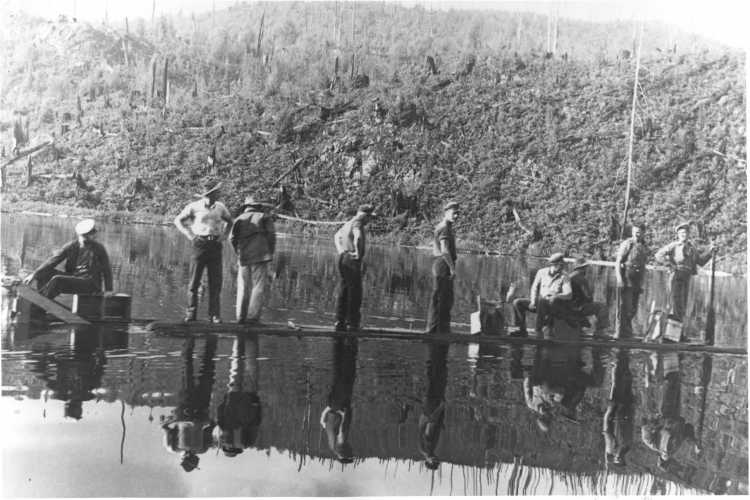“The
first week while we were waiting for our boots and rain proof
clothing, we were given forest fire fighting training which was
to be part of our duty besides our regular work. We learned that
on very hot and dry days we would not be away from camp but would
be on standby duty to respond as quickly as possible. Our camp
was divided into two groups with a third and smaller group who
would remain in camp to support or replace the main crews in case
of injury or other reasons.”
“Our
camp was situated 12 miles [19 km] southwest of Campbell River
in an area where a very large fire had burned out many square
miles of forest in 1938 which was four years before we arrived.
For miles in all directions our eyes could see the destruction
as a result of that fire. What remained were soot blackened “snags”
as they were called. These ranged from six foot [1.8] high stumps
to two hundred foot [60 m] giants.”
“During
the summer months it can get quite warm on Vancouver Island and
also very dry. It is during this hot and dry season that forest
fires are the most likely to get started. It was one of these
days when every thing had become so tinder dry that the slightest
spark could set off a fire. Our area was exceptionally susceptible
because the re-growth since the fire of 1938 had not reached the
stage of protective greenery. A few times we had tested the inflammability
of the ground cover. Even when there was almost nothing to burn
but a little moss growth, a lighted cigarette could easily start
a fire which spread so fast that we very quickly put it out with
loose dirt.”
 |
| Using a log boat to travel to forest fires. |
“Every
morning when we arrived at the fire it was plain that it had not
stopped progressing farther into the forest. Every morning we
had to reconnect our length of hoses farther up the mountain.
The last days we were using three pumps, the second being about
3000 feet [900 m] up from our main pump. The main pump was situated
in a sort of swamp which was considered to be safe from the fire
reaching it. It was placed next to a spring which supplied us
with what must have been millions of gallons of water. The second
pump was much smaller as it had to be carried up the hill every
morning and carried down when we shut down in the evening. During
the last few days we used a yet smaller pump from which was used
only a half inch garden hose and the farther up the hill we went
the less water pressure we had. The last day we pumped it was
only a trickle coming through the nozzle which was very frustrating,
because after all the work getting it up there and then being
so ineffective. I do not think any of us ever worked as hard before
that, and certainly not after. We fought fire every day for over
five weeks and the last [day] when we headed back we had become
quite discouraged and were wondering what more could be done to
halt the fire's progress. The answer came even before we went
to bed. A light rain started to fall right after supper and we
all went outside, stood in the rain and silently prayed for it
to last at least three days, and it did. We had those three days
of rest and were thankful that what we had not been able to do
with all our hard work, God and nature was doing so effortlessly
and effectively. [ASM, 30-49]
 David Jantzi worked in BC fighting forest fires which was hard
work. He had to hike up a mountain for 10 miles, carrying
the fire fighting equipment to get to the fire.
David Jantzi worked in BC fighting forest fires which was hard
work. He had to hike up a mountain for 10 miles, carrying
the fire fighting equipment to get to the fire.


